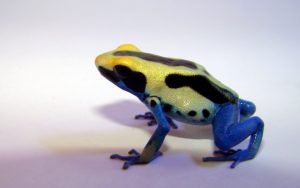
In dyeing poison frog, HSC production moves from the kidney to the bone marrow during metamorphosis to avoid damage from sunlight that’s harsher on the surface of the earth than in the water, new study suggests. (Credit: Wikimedia Commons)
Blood stem cells may have evolved to inhabit bone tissue to avoid DNA damage from UV rays, a Harvard study suggests.
Also known as haematopoietic stem cells (HSCs), these cells are tasked with making blood — a medley of about a dozen cell types that move oxygen around the body, fight infections and help wounds heal. Because blood has to be replenished daily throughout life, the HSCs must remain flawless or else they could seed leukemia and other diseases.
In humans and other land vertebrates, animals with spines and blood systems, the HSCs reside in the spongy tissue inside the bone called the bone marrow. In fish, however, the HSCs are found in the kidneys. Regardless of location, it’s thought that the stem cells’ microenvironment provides protection from harmful influences that could mutate their DNA and spell disease down the line.
That land and water vertebrates harbor the HSCs in such different parts of the body has puzzled researchers for decades. Now research from Leonard Zon’s group, from Harvard University, suggests that land animals evolved to produce HSCs in the bone marrow to avoid UV rays.
There’s ample evidence that UV light causes DNA damage. We’re reminded of this every day—those graced with more melanin pigment in their skin are naturally protected, but the rest of us must wear sunscreen to avoid burns and ultimately skin cancer.
To study the effect of sunlight on the HSCs, the researchers turned to zebrafish, a small freshwater species commonly used in research. They noticed dark, melanin-rich spots on the skin above both kidneys in fish larvae. After removing the melanin (using fish mutants that do not produce any pigment), and shining the UV light onto the larvae, the researchers saw a rise in UV-induced DNA mutations in the HSCs compared to normal, pigmented larvae.
The UV dose used in the study corresponds to sunlight exposure of about 15 minutes at UV indices of 5-10. The same amount of sunlight would give a fair skinned person a sunburn.
In another experiment, the researchers turned the fish larvae upside down and shone the UV light through their bellies, which are almost never naturally exposed to sunlight and have no melanin cover. Now both normal (pigmented) and mutant (non-pigmented) larvae had comparable amounts of DNA damage in their HSCs. Together, the findings suggest that melanin spots act as “parasols” to protect the HSCs from sunlight coming from above as they would naturally encounter it.
A survey across the tree of life revealed melanin spots are present in diverse kinds of fish. Even the sea lamprey, our most distant vertebrate cousin, has them, suggesting that the spots first appeared in the earliest aquatic vertebrates some 500 million years ago.
What does this have to do with our own blood-making bones? The Zon paper shows that sunlight is an evolutionary force that can shape the HSC microenvironment by evolving darkened skin to protect it. It does not, however, provide direct evidence that the reason our HSCs are in the bone marrow is to avoid the sun.
But this theory becomes even more appealing if you look at amphibia, the likes of frogs, newts and salamanders, which inhabit both the aquatic and terrestrial worlds. They typically start their lives in the water as free-swimming larvae before undergoing metamorphosis into four-legged land creatures. It turns out that tadpoles, which make their HSCs in the kidneys (as well as in the liver), also have the melanin parasols, just like the fish. Frogs, on the other hand, make their HSCs in the bone.
When the researchers examined, in the dyeing poison frog, when during metamorphosis this shift occurs, they found it to coincide with the time when the tadpoles start to grow legs as they prepare to leap on the land. They think that the shift is driven by the evolutionary pressure to avoid damage from sunlight, which is more harsh on the surface of the earth than in the water.
It could well be that a similar scenario played out 400 million years ago: by moving their HSCs into sun-proof bones, our predecessors were better suited to successfully colonize the land.
In addition, the authors argue that their findings open the door to new research with implications for cell therapy. Now that they have established that the pigmented cells are an important part of the HSC niche in the fish, the team plans to study in more detail how these cells interact. This research has the potential to unearth new biological processes that could, in turn, help improve bone marrow and HSC transplants in patients.
Jovana Drinjakovic
Latest posts by Jovana Drinjakovic (see all)
- Canadian immunotherapy holds promise for patients with brain cancer - September 9, 2020
- Could stem cells be enlisted to battle COVID-19? - March 26, 2020
- Study reveals large differences at the molecular level between stem cells grown on different biomaterials - April 18, 2019






Comments